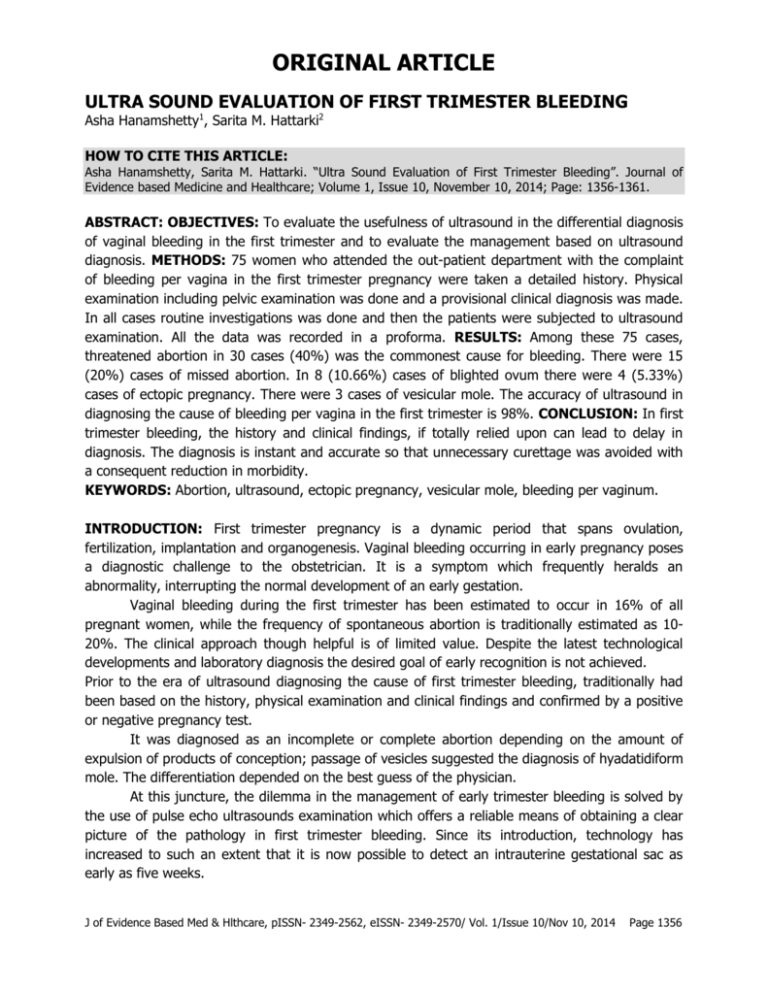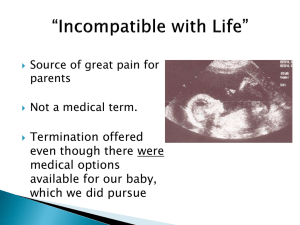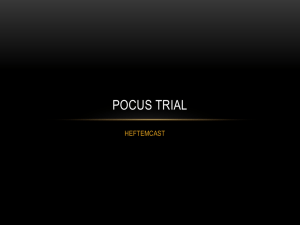original article ultra sound evaluation of first trimester bleeding
advertisement

ORIGINAL ARTICLE ULTRA SOUND EVALUATION OF FIRST TRIMESTER BLEEDING Asha Hanamshetty1, Sarita M. Hattarki2 HOW TO CITE THIS ARTICLE: Asha Hanamshetty, Sarita M. Hattarki. “Ultra Sound Evaluation of First Trimester Bleeding”. Journal of Evidence based Medicine and Healthcare; Volume 1, Issue 10, November 10, 2014; Page: 1356-1361. ABSTRACT: OBJECTIVES: To evaluate the usefulness of ultrasound in the differential diagnosis of vaginal bleeding in the first trimester and to evaluate the management based on ultrasound diagnosis. METHODS: 75 women who attended the out-patient department with the complaint of bleeding per vagina in the first trimester pregnancy were taken a detailed history. Physical examination including pelvic examination was done and a provisional clinical diagnosis was made. In all cases routine investigations was done and then the patients were subjected to ultrasound examination. All the data was recorded in a proforma. RESULTS: Among these 75 cases, threatened abortion in 30 cases (40%) was the commonest cause for bleeding. There were 15 (20%) cases of missed abortion. In 8 (10.66%) cases of blighted ovum there were 4 (5.33%) cases of ectopic pregnancy. There were 3 cases of vesicular mole. The accuracy of ultrasound in diagnosing the cause of bleeding per vagina in the first trimester is 98%. CONCLUSION: In first trimester bleeding, the history and clinical findings, if totally relied upon can lead to delay in diagnosis. The diagnosis is instant and accurate so that unnecessary curettage was avoided with a consequent reduction in morbidity. KEYWORDS: Abortion, ultrasound, ectopic pregnancy, vesicular mole, bleeding per vaginum. INTRODUCTION: First trimester pregnancy is a dynamic period that spans ovulation, fertilization, implantation and organogenesis. Vaginal bleeding occurring in early pregnancy poses a diagnostic challenge to the obstetrician. It is a symptom which frequently heralds an abnormality, interrupting the normal development of an early gestation. Vaginal bleeding during the first trimester has been estimated to occur in 16% of all pregnant women, while the frequency of spontaneous abortion is traditionally estimated as 1020%. The clinical approach though helpful is of limited value. Despite the latest technological developments and laboratory diagnosis the desired goal of early recognition is not achieved. Prior to the era of ultrasound diagnosing the cause of first trimester bleeding, traditionally had been based on the history, physical examination and clinical findings and confirmed by a positive or negative pregnancy test. It was diagnosed as an incomplete or complete abortion depending on the amount of expulsion of products of conception; passage of vesicles suggested the diagnosis of hyadatidiform mole. The differentiation depended on the best guess of the physician. At this juncture, the dilemma in the management of early trimester bleeding is solved by the use of pulse echo ultrasounds examination which offers a reliable means of obtaining a clear picture of the pathology in first trimester bleeding. Since its introduction, technology has increased to such an extent that it is now possible to detect an intrauterine gestational sac as early as five weeks. J of Evidence Based Med & Hlthcare, pISSN- 2349-2562, eISSN- 2349-2570/ Vol. 1/Issue 10/Nov 10, 2014 Page 1356 ORIGINAL ARTICLE Therefore a study was taken up to evaluate the usefulness of ultrasound in the differential diagnosis of vaginal bleeding in the first trimester. To compare the fallacy rates of clinical diagnosis and diagnosis with ultrasound examination in the first trimester. To evaluate the prognostic value of ultrasound in threatened abortion diagnosed by sonar. To diagnose the coincidental abnormalities and to evaluate the management based on ultrasound diagnosis. In the era of foetal medicine Donald’s vision of sonographic diagnosis of handicaps even before the child passes through the valley of the shadow of birth yet be fulfilled. The diagnoses of multiple pregnancies in early gestation and low lying placenta which migrate upwards are virtually impossible by clinical methods. Hence this noninvasive, safe, rapid and extremely accurate investigation was evaluated. METHODS: In the present study 75 women who attended the out-patient Department of. Obstetrics and Gynaecology at C. G. Hospital and Bapuji Hospital with the complaint of bleeding per vagina in the first trimester pregnancy during August 1991 to February 1993 were included. Cases were selected randomly. Patients up to 12 weeks of pregnancy calculated from the first day of the last menstrual period with bleeding per vagina were included in the study. In all cases, a detailed history, physical examination including pelvic examination was done and a provisional clinical diagnosis was made. In all cases routine investigations like hemoglobin blood grouping and Rh-typing, VDRL, urine analyses were done. Then the patients were subjected to ultrasound examination. All the data was recorded in a proforma. In ultrasound examination following findings viz., size of the uterus, presence of gestational sac, size and location of the gestational sac, gestational age compared to the period of amenorrhoea, whether the margins of the gestational sac are intact or crenated were noted. Foetal pole with crown rump length (CRL), cardiac pulsation, foetal movements and presence of fluid in the cul-de-sac were noted. Adnexa were scanned to rule out ectopic gestation and other pathology. All women those who were reported as, threatened abortion were regularly followed up and were managed accordingly. DISCUSSION: Out of 75 cases, there were 30 cases (40%) of threatened abortion, missed abortion in 20%, blighted ovum and incomplete abortion in 10.67% and 12% each respectively. Complete abortion in 8% of the cases, molar gestation was in 2.67% of cases and 5.33% of ectopic pregnancy was found. There was one case of pregnancy associated with sub serous fibroid and one case of pregnancy with IUCD (intrauterine contraceptive device). The present study co-relates well with the findings in the category of threatened abortion and blighted ovum to that of JE Drum's study1,2, incidence of molar pregnancy is same as that of Neelam Bhardwaj and Malhotra and Saxena3. J of Evidence Based Med & Hlthcare, pISSN- 2349-2562, eISSN- 2349-2570/ Vol. 1/Issue 10/Nov 10, 2014 Page 1357 ORIGINAL ARTICLE Ultrasound findings Threatebed abortion Missed abortion Blighted ovum Incomplete abortion Complete abortion Hydatidiform mole Pregnancy with Cu-T Delayed periods Low lying placenta DUB Ectopic pregnancy Pregnancy with uterine malformation Multiple pregnancy J. E. Drum's1 study 32.5% 10.8% 11.1% 28.1% 17.4% 0.1% - Ramsofat2 study Neelam3 Bhardwaj Malhotra & Saxena Present study 70% 12% 14% 1.33% 1.33% - 57% 8% 26% 4% 1.1% 2% 2% - 70% 12% 14% 1.33% 1.33% 1.33% 40% 20% 10.67% 12.1% 8.0% 4.0% 1.33% 5.33% - - - - - - - - - - Table 1: Comparison of the results of the present study with other studies Age wise distribution of patients shows 54.67% were in 20-25 years age group, 26.67% were in 25-30 years age group, 9.33% were beyond 30 years and 9.33% were under 20 years of age. There were primigravida 22 cases (29.33%), gravida 2 and 3 - 42 cases (56.00%) and gravida 4 and above 11 cases (14.67%). Category Threatened abortion Missed abortion Blighted ovum Incomplete abortion Complete abortion Molar pregnancy Ectopic pregnancy Pregnancy with fibroid Pregnancy with IUCD Clinical diagnosis 38 19 0 11 1 2 4 0 1 Ultrasound diagnosis 30 15 8 9 6 2 4 1 1 Clinical fallacy 8 (26.67%) 4 (26.67%) 8 (100%) 21 (22.22%) 5 (83.33%) 1 (100%) - Table 2: Comparision of clinical diagnosis and ultrasound diagnosis Ultrasonographically foetal cardiac motion was seen in 30 cases out of which 24 (80%) had favourable outcome; 6 (20%) had unfavourable outcome. Absence of foetal cardiac pulsation J of Evidence Based Med & Hlthcare, pISSN- 2349-2562, eISSN- 2349-2570/ Vol. 1/Issue 10/Nov 10, 2014 Page 1358 ORIGINAL ARTICLE indicates unfavourable outcome in all cases but presence of foetal cardiac motion does not necessarily indicate favourable outcome. In the group of patients who has bleeding for 4 days or less, (20 out of 53) i.e. 37.74% had favourable outcome. Favourable outcome is considered if pregnancy continued at least till 28 weeks and delivered a live normal baby. Several investigators have reported an increased incidence of abortion with low implantation Helmen et al 1969.4 The diagnosis of threatened abortion was made in 38 cases but ultrasound confirmed it only in 30 cases, giving a fallacious diagnosis in 8 cases i.e. 26.67% of cases. This is because all women coming with history of bleeding, with size of the uterus corresponding to the period of gestation was diagnosed as threatened abortions. Clinically there was fallacious diagnosis of 4 (26.67%) cases of missed abortion. None of the cases of blighted ovum could be diagnosed clinically. In 13 out of 38 cases clinically diagnosed as threatened abortion (34.2%) without an ultrasonic diagnosis, the pregnancies would have been continued without any benefit. The presence of a foetus with a crown rump length of 10 mm or more without foetal heart motion is diagnostic of a missed abortion (Subbagha) 5. Rajan6 et al in his study gives a figure of 4.9% missed abortion in first trimester pregnancy, out of which 25% of missed abortion diagnosed ultrasonographically proved to be vesicular mole on evacuation. Levi7 et al 1973 has stated that the measurement of BhCG was not definite indication of viability. In Jouppila's8 study 1980 missed abortion was the diagnosis in 18% of the patients. Molar pregnancy was diagnosed in 2 cases and the other case was misdiagnosed as missed abortion. During evacuation of the uterus, molar pregnancy was diagnosed and confirmed with histopathological report. Ultrasound is the most reliable and rapid method of diagnosing hydatidiform mole (Campbell 1972). Donald and Brown9,10 (1961) were the first to diagnose mole by ultrasound. In the present study there were 9 cases of incomplete abortion, of which 7 had mild to moderate bleeding. Two patients had severe bleeding. Blood transfusion was required for one case. All patients were subjected to D & E and products evacuated totally thus, minimizing uterine bleeding and ascending infection. There were 4 cases of (5.33%) of ectopic pregnancies. All four were tubal pregnancies. Culdecentesis was positive in all the 4 cases (100%). Ultrasound was done in all the patients and accuracy of ultrasound findings was 100%. All the four patients underwent emergency laparotomy. In the present study there was one case of pregnancy with subserous fibroid associated with bleeding. Diagnosis of fibroid with pregnancy allowed conservative line of management. There was one case of pregnancy with intrauterine device in sito associated with bleeding. Copper 'T" was removed and the patient continued her pregnancy to term and delivered vaginally a normal live baby. 1 2 3 4 Authors Romero11 Vassilokos12 Barone13 Wittman14 Diagnostic accuracy 100% (28) 100% (35) 100% (2) 98% (38) J of Evidence Based Med & Hlthcare, pISSN- 2349-2562, eISSN- 2349-2570/ Vol. 1/Issue 10/Nov 10, 2014 Page 1359 ORIGINAL ARTICLE 5 Present study 98% Table 3: The accuracy of diagnosis by ultrasound as compared with other authors is given below Present study correlates well with Wittman's study14. An accurate assessment of first trimester bleeding can be done but ultrasound from diagnostic and prognostic point of view. RESULTS: In this prospective study, the value of ultrasound in the diagnosis of cause of vaginal bleeding in the first trimester in 75 cases was assessed. This study also showed that the outcome was better if the bleeding was for less than 4 days. Among these 75 cases, threatened abortion was the commonest cause for bleeding. This was observed in 30 cases (40%). Out of them, 21 cases had full term delivery (70%). 4 cases had preterm vaginal delivery (13.33%), 3 cases ended in spontaneous abortion and 2 patients with threatened abortion underwent MTP and tubectomy. There were 15 (20%) cases of missed abortion. In 8 (10.66%) cases of blighted ovum, none of them were diagnosed clinically but ultrasound diagnosis was done accurately in all and confirmed after histopathological report. There were 4 (5.33%) cases of ectopic pregnancy. All 4 were tubal pregnancies. All 4 patients underwent emergency laparotomy and unilateral salpingectomy. There were 3 cases of vesicular mole. The diagnosis was confirmed by ultrasound in 2 cases and one case was misdiagnosed by ultrasound as missed abortion. Molar pregnancy was diagnosed after evacuation and confirmed with histopathological examination. In the present study ultrasound also helped to diagnose complete abortion, fibroid with pregnancy and copper "T" with pregnancy accurately. The accuracy of ultrasound in diagnosing the cause of bleeding per vagina in the first trimester is 98%. Hence, an accurate assessment of first trimester bleeding can be done by ultrasound. CONCLUSION: In the present study it has played a very important role in the diagnosis of cause of first trimester bleeding. It can diagnose threatened abortion positively. Missed abortion, blighted ovum and incomplete abortion, ectopic gestation and molar pregnancy are reliably diagnosed. Patient with complete abortions were accurately identified, so that unnecessary curettage was avoided with a consequent reduction in morbidity. Therefore ultrasound diagnosis in first trimester bleeding is a key diagnostic tool. BIBLIOGRAPHY: 1. Drumm J.E., Clinch J.: Ultrasound in management of clinically diagnosed threatened abortion. Br. Med. J. 2: H2H: 1975. 2. Rama Sofat: Ultrasound evaluation of bleeding in the early pregnancy. The J. Obst. and Gynae. of India, 1987;37(3):344. 3. Neelam Bharadwaj: Sonography as an aid in the monogenetic of bleeding in early pregnancy. FOGST 1988; 38(6):640-642. 4. Kobayashi M, Hellman L.M., Tfillisti L.P.: Ultrasound an aid in the diagnosis of ectopic pregnancy. Am. J. Obst. and Gynae. 103: 1131, 1969. J of Evidence Based Med & Hlthcare, pISSN- 2349-2562, eISSN- 2349-2570/ Vol. 1/Issue 10/Nov 10, 2014 Page 1360 ORIGINAL ARTICLE 5. Sabbagha: Diagnosis of vesicular mole - Ultrasound in high risk pregnancy. 6. Rajan: Ultrasonography in Human reproduction. 7. Levi S.: Diagnostic use of ultrasound in abortion. A study of 250 patients Int. J. CY and OB, 11(5), 1973 8. Jouppila P: Clinical and ultrasound aspects in the diagnosis and follow up of patients with early pregnancy failure. Obst. and Gynae. Survey, 1981; 36:553 9. Donald I: Ultrasonic echo sounding in Obst. and Gynaeco. Diagnosis Am. J. OC. 93: 935, 1965 10. Brown T.W., Filly R.A., Laing S.C., Barton J.: Analysis of ultra sonographic criteria in evaluation for ectopic pregnancy. A.J.R. 1978: 131, 967. 11. Romero R.: Diagnostic ultrasound in first trimester of pregnancy. C.O.C. 1984; 27(2):286. 12. Vassilakos P. Riotten C, Kajii T.: Hydatidiform mole. A morphologic and cytogenic study with some clinical consideration Am. J. Obst. and Gynae. 1977, 127, 167. 13. Barone CM: Ultrasound diagnosis of hydatidiform mole with a co-existant foetus. Radiology, 1977: 12U, 798. 14. Wittmann B.K. et al: Molar pregnancy, early diagnosis by ultrasound J. Clin. Ultrasound 1981, 9: 153. AUTHORS: 1. Asha Hanamshetty 2. Sarita M. Hattarki PARTICULARS OF CONTRIBUTORS: 1. Associate Professor, Department of OBG, BRIMS, Bidar. 2. Associate Professor, Department of OBG, BRIMS, Bidar. NAME ADDRESS EMAIL ID OF THE CORRESPONDING AUTHOR: Dr. Asha Hanamshetty, Sangameshwar Hospital, # 8-11-40, Near Forest Office, KPTCL Road, Bidar. E-mail: praveenshetty13@gmail.com Date Date Date Date of of of of Submission: 24/10/2014. Peer Review: 25/10/2014. Acceptance: 04/11/2014. Publishing: 10/11/2014. J of Evidence Based Med & Hlthcare, pISSN- 2349-2562, eISSN- 2349-2570/ Vol. 1/Issue 10/Nov 10, 2014 Page 1361






